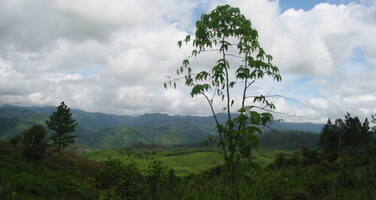Río Plátano Biosphere Reserve
Factors affecting the property in 2009*
- Illegal activities
- Invasive/alien terrestrial species
- Land conversion
- Livestock farming / grazing of domesticated animals
- Management systems/ management plan
- Water infrastructure
Factors* affecting the property identified in previous reports
a) Illegal settlements;
b) Illegal livestock grazing and agricultural intrusions;
c) Illegal logging;
d) Poaching;
e) Invasive exotic species;
f) Management deficiencies;
g) Potential impacts from hydroelectric development project Patuca II.
UNESCO Extra-Budgetary Funds until 2009
Total amount provided to the property: USD 80,000 (in addition to approximately USD 100,000 of in-kind technical assistance) under the management effectiveness assessment “Enhancing our Heritage” project
International Assistance: requests for the property until 2009
Total amount approved : 198,000 USD
| 1996 | Conservation strategy and preparation of a management ... (Approved) | 30,000 USD |
| 1988 | Equipment for Rio Platano Biosphere Reserve (Approved) | 20,000 USD |
| 1987 | Consultant services, training and equipment for ... (Approved) | 30,000 USD |
| 1985 | Strengthen protection and management of Rio Platano ... (Approved) | 20,000 USD |
| 1983 | Implementation of protective measures, of training ... (Approved) | 26,000 USD |
| 1982 | Financial contribution towards ecodevelopment ... (Approved) | 67,025 USD |
| 1982 | Rio Platano Biosphere Reserve (Approved) | 4,975 USD |
Missions to the property until 2009**
1995 and 2000: IUCN monitoring missions; 2003 and 2006: World Heritage Centre / IUCN reactive monitoring missions
Conservation issues presented to the World Heritage Committee in 2009
The property was inscribed on the List of World Heritage in Danger due to the presence of unauthorized settlements within its boundaries, illegal logging and the threat from an advancing agricultural frontier. To the west and south, the property is bordered by new settlements established by small scale farmers and ranchers looking for lands, and to the east by indigenous communities. The northern part of the property borders on the Caribbean and harbours several small indigenous settlements, though an increasing number of colonists are arriving here as well. The absence of orderly land allocation structures has resulted in a thriving informal land market, further exacerbating deforestation. Important efforts have been made to establish a formal cadastre, with the support of German development assistance and significant progress has been made. Vigorous presence of the military on the property boundaries, along with the passing of clear laws removing loopholes that had been used to legalize timber obtained from the property have been closed. These developments were the basis for the removal of the property from the List of World Heritage in Danger in 2007.
The World Heritage Centre sent a letter communicating Decision 32 COM 7B.38 to the State Party on 21 August, 2008 along with a follow-up letter on 1 February 2009. Further email and telephone communications took place in February and March 2009 in an effort to communicate the urgency of responding to the World Heritage Committee’s request.
No report has been received from the State Party.
This property, having only recently been removed from the List of World Heritage in Danger, is the source of on-going unsolicited reports to the World Heritage Centre and to IUCN from field level observers which indicate that on-going management issues remain to be addressed, in particular:
a) The advance of the agricultural frontier into the property boundaries;
b) Important illegal seasonal commercial fisheries in the rivers and iii) hunting of mammals such as tapir, peccary and paca.
A further report from Global Witness entitled “Illegal Logging in the Rio Platano Biosphere Reserve” raises further concerns over the integrity of the property. In the absence of the state of conservation report from the State Party, these field reports raise serious issues over the implementation of the 2006 monitoring mission recommendations.
Summary of the interventions
Decisions adopted by the Committee in 2009
33 COM 7B.37
Río Plátano Biosphere Reserve (Honduras) (N 196)
The World Heritage Committee,
1. Having examined Document WHC-09/33.COM/7B,
2. Recalling Decision 32 COM 7B.38, adopted at its 32nd session (Quebec City, 2008),
3. Regrets that the State Party has not provided a state of conservation report for the property, as requested in Decision 32 COM 7B.38;
4. Reiterates its request to the State Party to submit to the World Heritage Centre, by 1 February 2010, a report on further progress achieved in the implementation of the recommendations made by the 2006 monitoring mission, including a response to the report on illegal logging by Global Witness, for examination by the World Heritage Committee at its 34th session in 2010, with a view to consider the inscription of the property on the List of World Heritage in Danger.
Draft Decision: 33 COM 7B.37
The World Heritage Committee,
1. Having examined Document WHC-09/33.COM/7B,
2. Recalling Decision 32 COM 7B.38, adopted at its 32nd session (Quebec City, 2008),
3. Regrets that the State Party has not provided a state of conservation report for the property, as requested in Decision 32 COM 7B.38;
4. Reiterates its request to the State Party to submit to the World Heritage Centre, by 1 February 2010, a report on further progress achieved on the implementation of the recommendations made by the 2006 monitoring mission, including a response to the report on illegal logging by Global Witness, for examination by the World Heritage Committee at its 34th session in 2010.

Exports
* :
The threats indicated are listed in alphabetical order; their order does not constitute a classification according to the importance of their impact on the property.
Furthermore, they are presented irrespective of the type of threat faced by the property, i.e. with specific and proven imminent danger (“ascertained danger”) or with threats which could have deleterious effects on the property’s Outstanding Universal Value (“potential danger”).
** : All mission reports are not always available electronically.

